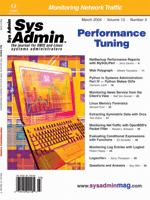 New
Messages New
Messages
To: Ed Schaefer
Subject: "Managing System Identity with changeident"
Ed, thanks to you and John for the Sys Admin article, "Managing
System Identity with changeident". It is very timely! I downloaded
the source code.
From your experience, can I expect the list of modules that you've
identified for Solaris 5.7 to be the same ones necessary to change
the identity of a Solaris 5.8 system?
Thanks, in advance, for your help.
Mike Box
Systems Administrator
Mike, thanks for writing and taking an interest in our "changeident"
script. I ran this by John and he thinks that as far as changeident
is concerned there should be no difference between Solaris 7 and 8.
John says "at least as far as he's read".
Also, the modules presented might not agree with your environment
or you may have some issue we're not aware of. Obviously, the
server should be tested thoroughly. If you happen to find an issue,
we'd be interested to know what it is. Perhaps we can share
it with other readers.
Regards,
Ed
To whom it may concern,
After reviewing Volume 12, Number 12 for December 2003, I have
spotted the following minor clerical error in the article "Backup
Scripts from UnixReview.com, 3rd Edition" edited by Ed Schaefer:
Page 28/Page 30, near the top (first code segment) it reads:
dd of=/dev/rmt/0 bs=10k
which is stated that it is used to send the data in 10k blocks.
This is correct, as the manual for dd(1) states that bs will force
ibs=BYTES and obs=BYTES. However, in the code presented on page
30, Listing 1, the command dd uses "obs=10k", which
is just for the output bytes versus both output and input. Although
both methods can be used, it may be desired to either use "obs"
instead of "bs" on page 28, or explain the differences
between obs, ibs, and bs so that a reader who may be unfamiliar
with the usage of dd would understand the reasons behind
why it is different.
Thanks,
Ryan Yagatich
Hello Ryan,
Thank you for your comments. As you correctly noted, there's
a difference between "dd obs=10k", which will block the
output in chunks of 10k, and "dd bs=10k", which will use
10k blocks for both input and output. In the article, the important
part was to block the output to a tape drive in 10k blocks. Both
mentioned usages of dd
work, although your suggestion of using "obs=10k" in both
cases would have been sufficient.
Heiner Steven
Dear Sys Admin,
I don't know how many times I've thought to myself "I
should write to Sys Admin and tell them how much I enjoy
their publication," but it must be a hundred times. Actually,
I feel rather guilty. For years, I eagerly awaited a hand-me-down
copy from colleagues. Finally it dawned on me that I should just
get a subscription. I think Sys Admin might suffer from this
"hand-me-down" problem more than other magazines, because
SAs tend to be so closely bound that sharing magazines/scripts/code
is quite common.
I work in a "high performance computing" (HPC) environment,
and enjoy all of the articles related to such. Sys Admin
has had a nice share of late regarding the topic. Please remember
that some solutions do not lend themselves to network distributed
computing, and SMP is still quite important despite all the new-found
network computing religion. Any articles on optimizing SMP would
be appreciated (kernel tuning, monitoring tools).
Thanks and Best Regards,
Wayne Johnson
Dear Sys Admin,
I seem to always pick up great hints from your magazine. In January
you provided a really good article by Hal Pomeranz regarding a DNS-based
approach to block advertising.
At the time I was going crazy remotely trying to pick the evil
d(a)emons out of my father's PC. He, being the trusting type,
followed a URL that led to spyware, annoyware, etc., rendering his
computer useless. I'd run AdAware, get rid of 130+ items, and
in two hours another run would yield as many. (That's a Win98
box, till I can get a new one to him in a few days, which will be
Win2K.)
He has a cable modem, but I have him using my DNS servers here.
I looked at the logs from his DNS requests, and made zone files
for all of those domains on my server(s). Well, that worked great.
The d(a)emons are still running, but can no longer make his computer
useless. And I no longer see very many banner ads.
So, thanks Sys Admin and Hal Pomeranz! This one was a good
one, and I'm telling anyone who'll listen.
George J. Csahanin
Austin, TX
Dear Readers,
We received a few letters in response to our February feature
"Securing Intranets with IPCop" by Phil Barnett and Bryan
Smith. Some of you expressed concern that the SmoothWall project,
from which IPCop was forked, and its developers were not acknowledged
in that article. Because there have been so many dedicated contributors
to these projects over the years, the authors chose to thank all
the developers collectively. For more information (including history
and names of contributors) for both projects, please see: http://www.ipcop.org
and http://www.smoothwall.org.
| 
